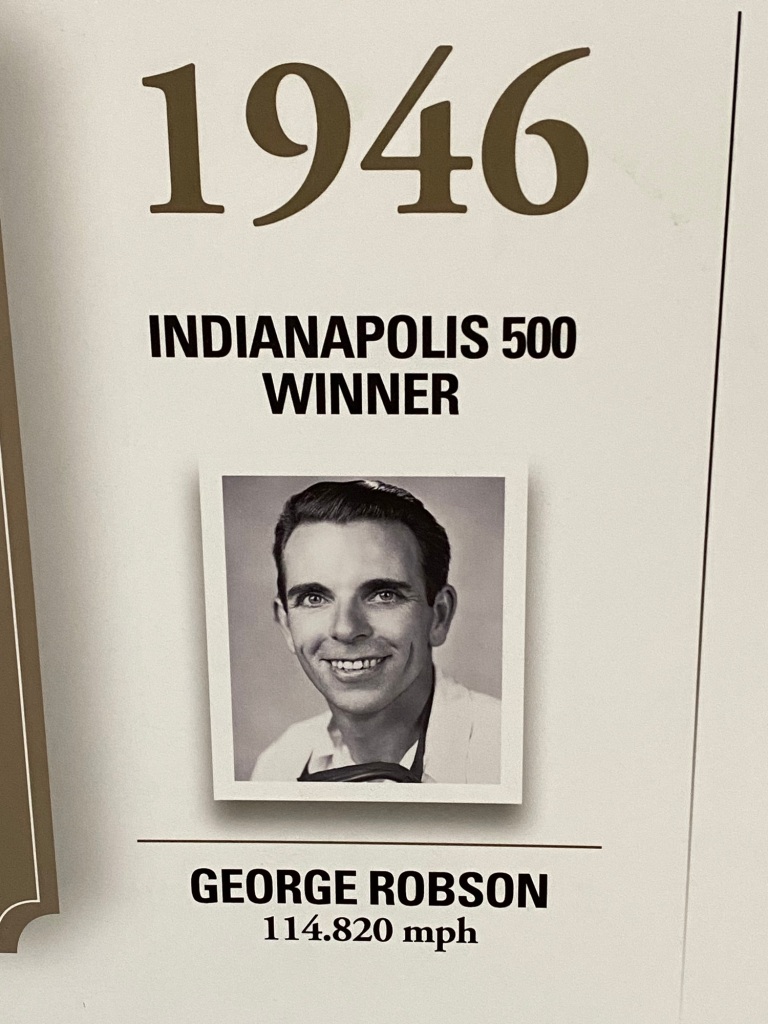By now everyone knows how much I love my timeline piece from the Indianapolis Motor Speedway Museum. After nearly three months it is officially mounted on my basement wall and I am trying to put together a fun IndyCar area in my basement. As I’ve worked on this I realize how little I know about the men who won the Indy 500 between 1946-1956. I’ve decided to do my own countdown to the 500 where each week I showcase a different winner on my timeline. Since both Mauri Rose and Bill Vukovich have back to back wins I will combine 1947/48 and 1953/54 allowing for a post a week until race day. The posts won’t be extremely detailed but hopefully are a fun way to learn more about the drivers from the era.
George Robson, winner of the 1946 Indianapolis 500, is probably the driver I know the least about and one of the reasons I came up with this blog series. Even his name is not familiar to me.
The Indianapolis Motor Speedway was closed during World War II. The Indianapolis 500 was not run but the track was also not in use as it had been during the First World War. The use of the Speedway was offered to the government but due to increases in airplane technology the facility was too small to serve as a base for the military aircraft as it had in World War I. The entire Speedway was in shambles. Weeds and trees were growing up through the track and owner Eddie Rickenbacker was open to selling the facility. Former winner, Wilbur Shaw, set out to find a buyer for the Speedway and met with Anton “Tony” Hulman. Rickenbacker sold the Speedway to Tony Hulman and Wilbur Shaw became president and general manager of the Speedway.
The task of repairing the Speedway was a huge one. Grass and weeds were waist high and bleachers were falling down. The work was done, including new bleachers and even a new Pagoda, and fans flocked to the Speedway eager to see cars back on track. The cars were all prewar models and at the end of the 1946 race only 9 cars were still running. George Robson took the checkered flag.
George was born in England in 1909. In 1911 his family moved to Canada and then moved to the United States in 1924, settling in Huntington Park, California. He married Marjorie June in 1933 and had a son the following year named George William. George began his racing career in the mid 1930s and his first experience at the Indianapolis 500 was as a relief driver. Robson would qualify for both the 1940 and the 1941 Indianapolis 500, finishing in 23rd and 25th place.
In 1946 Robson qualified on the fourth day of qualifying but with the fifth fastest time. He started in 15th position and took the lead on lap 56. With the exception of pit stops he held onto the lead the rest of the race. After the race there was a bit of controversy as Robson was accused of not following the rules by staying in his car during the pit stops but it was determined that he was the winner.
The Indianapolis 500 win must have given Robson a boost of confidence because he went on to win 6 races (these were non points races) and was second in the points standings among championship races. Unfortunately, George Robson would lose his life at a race at Lakewood Speedway in Atlanta. It was a track know for being dusty and visibility was poor. George tried to avoid hitting Billy DeVore and was hit by George Barriner. Robson was not able to avoid DeVore. DeVore’s car went over a stone wall and he landed upside down in a creek. People from the crowd rescued him. Barringer had massive internal injuries and died a few hours later. George Robson’s car rolled and he was thrown to his death.
I guess I am not surprised to learn that George died shortly after his Indianapolis 500 win, it was often the case in these early days of racing. I do wish though that this first driver profile had ended on a happier note. While sad and tragic, I do hope you enjoyed learning a bit more about the 1946 winner and I look forward to posting each week about the men who won the Indianapolis 500.
This is my 200th blog post.
